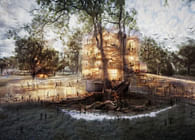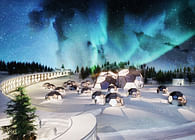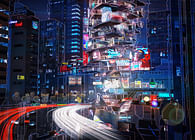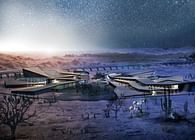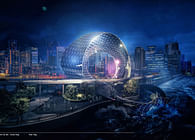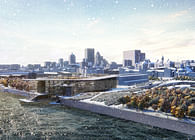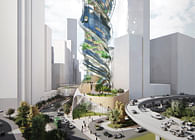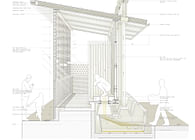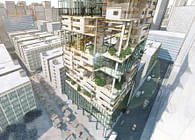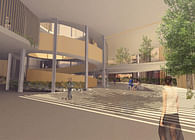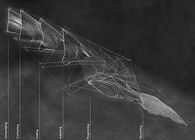
What will a city turn into when it is all about one company?
What will our city turn into when it is all about one company, when our city is not initially designed for, nor by corporation?
--------------------------------------------------------------------------------------------------------------
Top Place in Autumn World Campus Masters Selective Graduation Design Program 2020
Norminated Entry of The RIBA President's Medal Part 2
Honorable Mention in Team 20 Competition- 2020 Architecture & Urban Planning Graduation Projects Competition
--------------------------------------------------------------------------------------------------------------
What will a city turn into when it is all about one company?
What will our city turn into when it is all about one company, when our city is not initially designed for, nor by corporation?
In the history of company town, a form of corporate urbanism, companies built their own industrial towns and workers, in their own wills, came to those, seeking for a better life. Nowadays, mega-corporations no longer build their own towns, but buy their own cities, cities that we are living in. Nowadays, citizens do not go to corporate towns, corporate city comes to us.
Initiated with observation of revival of company town urbanism, with an approach of taking over existing cities gradually, under assumption that mega-corporations’ expansion and integration with present city will continue in coming decades, this thesis is interested in reviewing the change of role of architecture in an controlled urban environment under expansion of anchor mega-corporation, one observed potential of our future.
Corporate urbanism, especially for a city designed to suit for the growth of one mega-corporation, is a topic of controversy in the first place. One prosperous and controlled utopia in the corporate board’s eyes could be a “high-tech-low-life”, chaotic dystopia in grassroot laborers' view at the same time.
Subject of this thesis is Suwon-si, the city where the headquarters of Samsung is located, and a majority of citizens’ livelihood are dependent on the Samsung economy. A series of projections on the future of Samsung expansion, a search of alternative urban mindset under a corporate-dominant city, in existing city Suwon-si will be taken as the showcase to portray the future cybernetic society when the city is a corporate tool to plan its growth.
In terms of methodology to approach corporate urbanism, the idea of contradiction has been illustrated with the structure of the thesis. Two parallel sets of urban experience: one from the perspective of Samsung as a dominating corporation, and one from grassroot labors. The two sets, interweaving closely along time, construct a timeline of extreme corporate expansion, revolt of low-lives, supervision and controls, and eventually decline of the city, which portrayed the confrontation of communities, which have significant impacts on trajectory on both latter urban forms.
Understanding city as a subject of constant renewal, this thesis adapts a near-future setting where architecture built nowadays will persist as a legacy of the past-society in future. How their role changes along corporate expansion has posed a great question on the current discourse.
Meanwhile, the setting of corporate city has revolutionized the traditional mindset to design a city, as concepts taken for granted in our current discourse might shift. For instance, dominating with corporate properties has blurred the boundaries of public and private ownership in the city, which concept of city gridding based on clear definition of ownership has been challenged. These shifts of concept provide us a different perspective to review our current and think out of the box.
Exploring how a city will be designed differently from now is the primary goal of this thesis.
In architectural approach, this thesis takes the contemporary model of expansion, particularly with intention of vertical growth and densification of existing cities, to the extreme, speculating the collapse at its verge of limit. With the aid of the utmost setting of corporation, it is an attempt to examine existing flaws and critically review our traditional mindset of city, such as the efficiency of ground networking among high-rise, integration of buildings and technology given their contrasting difference in lifecycle.
In terms of design, projecting in character of the above corporation background, to cater the uncontrolled growth, urban matrix, driven by the background stories, is a direction of that both corporation and grassroot labor eventually being seduced by. Yet, at the same time, due to differences in approach (top-down controlled planning versus informal localized sprawling), very diverse urban forms have been developed consequently. Despite that these forms of urban matrix may appear as unrealistic in our current standard; they are an extension of the reflection of our current city and attempts of exploring alternative thinking in the method of arranging our city facing upcoming challenges.
Lastly, beyond its architecture, the narrative in this thesis is a reflection on this occurring mode of development in our society. Throughout this exploration, and projection of uncontrolled growth of corporations of our time toward such monistic society. This thesis is not suggesting the projection brought up in this thesis, a dystopian view of the current future, is our sole, destined outcome of how our society may go. It could be a pure imagination, or even fiction. But at the same time, it has a solid possibility of happening when the current path may go. It depends on the will of people, the will of our city, and the will of our time. Hence, ultimately, considering this projection as a warning, this thesis wishes to raise concern of architects and beyond to this rising phenomenon of corporate city, a menace to pluralistic values we enjoyed now.
Status: School Project
Location: Suwon-si, Seoul
Additional Credits: I would like to express my very great appreciation to my thesis
supervisor, Mr Wee, H. Koon, for his guidance to my thesis.
Special thanks to helpers,
Ashley Ma
Canossa Chan,
Jessy Yau
Yannie Ho









